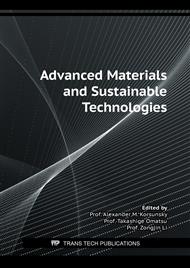[1]
S. Gupta., H.W. Kua, Effect of water entrainment by pre-soaked biochar particles on strength and permeability of cement mortar. Constr. Build. Mater. 159 (2018) 107-125.
DOI: 10.1016/j.conbuildmat.2018.08.075
Google Scholar
[2]
H. Lin, Effects of organo-modified montmorillonite on strengths and permeability of cement mortars. Cement. Concrete. Res. (2006).
DOI: 10.1016/j.cemconres.2005.11.013
Google Scholar
[3]
E. Vanagas., R. Kliukas., O. Lukoševičienė, A feasibility study of using composite reinforcement in transport and power industry structures. Transport. 32 (2017) 321-329.
DOI: 10.3846/16484142.2017.1342689
Google Scholar
[4]
S. Gupta, Effect of presoaked superabsorbent polymer on strength and permeability of cement mortar. Mag. Concrete. Res. 112 (2017) 1-14.
DOI: 10.1680/jmacr.17.00120
Google Scholar
[5]
M. Ramli., A.A. Tabassi, Effects of polymer modification on the permeability of cement mortars under different curing conditions: a correlational study that includes pore distributions, water absorption and compressive strength. Constr. Build. Mater. 28 (2012) 561-570.
DOI: 10.1016/j.conbuildmat.2011.09.004
Google Scholar
[6]
V. Han., S. Ros., H. Shima, Effects of sand content, superplasticizer dosage, and mixing time on compressive strength of mortar. Aci. Mater. J. 110 (2013) 23-31.
DOI: 10.14359/51684363
Google Scholar
[7]
G.A. Rao, Generalization of Abrams' law for cement mortars. Cem Concr Res. 31 (2001) 495-502.
DOI: 10.1016/s0008-8846(00)00473-7
Google Scholar
[8]
H. Eskandari-Naddaf., R. Kazemi, Ann prediction of cement mortar compressive strength, influence of cement strength class. Constr. Build. Mater. 138 (2017) 1-11.
DOI: 10.1016/j.conbuildmat.2017.01.132
Google Scholar
[9]
S. Zhu., W. Zhang., Q. Sun., S. Deng., J. Geng., C. Li, Thermally induced variation of primary wave velocity in granite from yantai: experimental and modeling results. Int. J. Therm. Sci. 114 (2017) 320-326.
DOI: 10.1016/j.ijthermalsci.2017.01.008
Google Scholar
[10]
Z. Lafhaj., M. Goueygou., A. Djerbi., M. Kaczmarek, Correlation between porosity, permeability and ultrasonic parameters of mortar with variable water/cement ratio and water content. Cement. Concrete. Res. 36 (2006) 625-633.
DOI: 10.1016/j.cemconres.2005.11.009
Google Scholar
[11]
Z.T. Zou., J.N. Meegoda, A validation of the ultrasound wave velocity method to predict porosity of dry and saturated cement paste. Adv. Civ. Eng. 2018 1-8.
DOI: 10.1155/2018/3251206
Google Scholar
[12]
Q. Sun., J.S. Geng., W.Q. Zhang, Variation of wave velocity and thermal conductivity of concrete after high-temperature treatment. Environ. Earth. Sci. 76 (2017) 88.
DOI: 10.1007/s12665-017-6397-z
Google Scholar



